Webflow vs WordPress: Which Platform is Best for Australian Marketers?
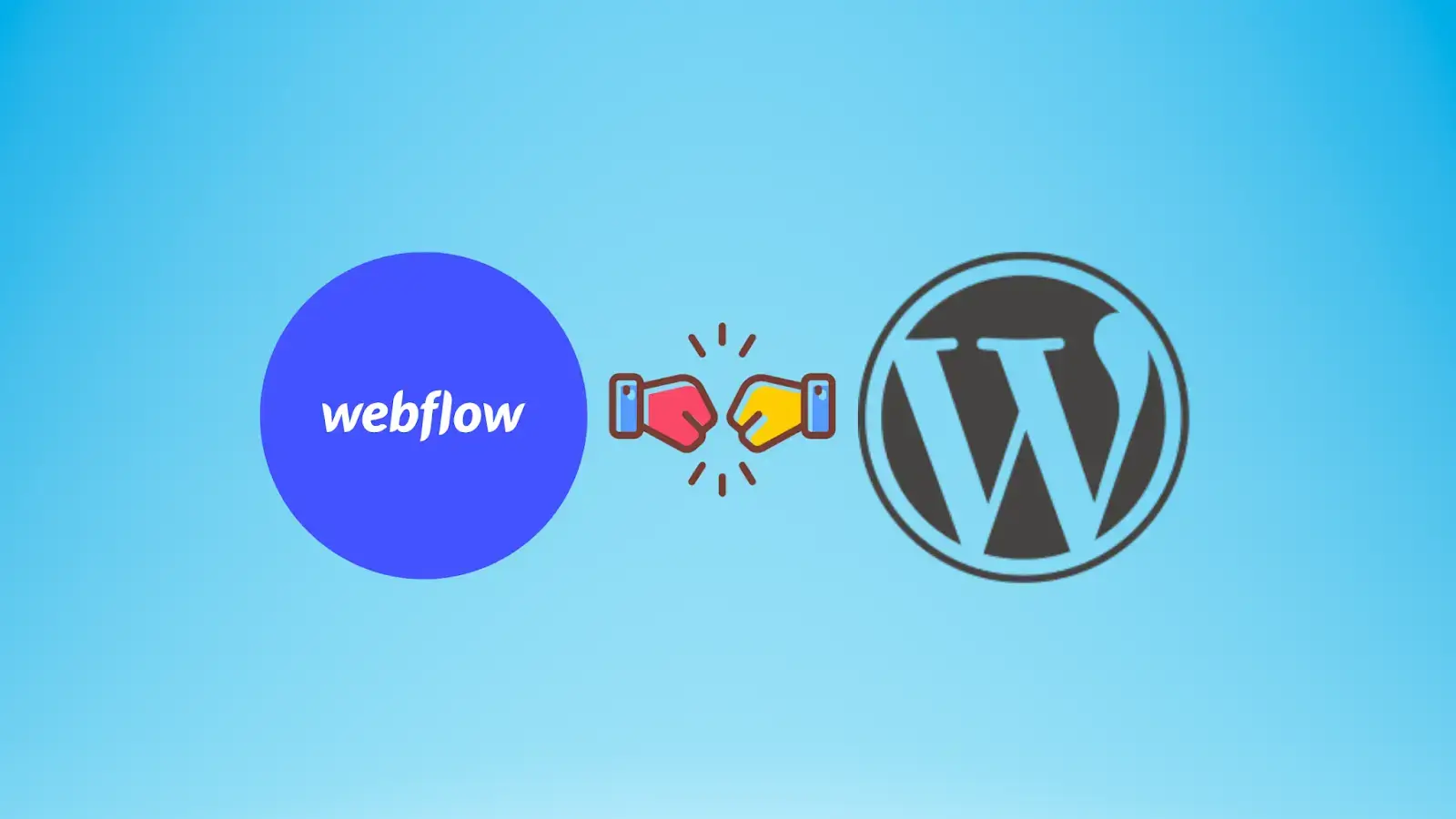
Table of Contents
- Webflow vs WordPress: What marketers are looking for in their websites?
- How Webflow Helps Marketers? A Quick Overview
- Detailed Features Comparison of WordPress vs Webflow
- Pricing for Webflow
- Limitations of Webflow for Marketers
- How WordPress Helps Marketers? Quick Overview
- Features & Limitations: Comparison Table for Webflow vs WordPress
- How We Compared Webflow & WordPress?
- Final Verdict: Webflow vs WordPress – Which One Should You Use?
The biggest worry of any digital marketer is having a bad website to market. Your website is the foundation of your business, and choosing the right development platform is crucial for success.
When it comes to choosing a sustainable platform for your business, two platforms standout: Webflow & WordPress.
From a top-down view, both of these platforms are great and have their own rich set of features. However, choosing one that guarantees long-term stability for your business, and scalability in times of needs, is still hard.
Being a website development agency, we’ve guided many clients through this critical decision by thoroughly evaluating their unique website requirements. Drawing on our experience, we can help you make a solid choice that aligns with your marketing goals and sets your business up for success.
Whether you prioritise design flexibility, ease of use, or SEO capabilities, this guide will equip you with the insights you need to make an informed decision when choosing between Webflow or WordPress.
What You’ll Learn:
- Compare Webflow’s no-code drag-and-drop with WordPress’s theme-based setup.
- See how Webflow’s modular design stacks up against WordPress’s extensive customisation.
- Review Webflow’s basic SEO features versus WordPress’s advanced plugins.
- Contrast Webflow’s separate CMS plan with WordPress’s Opensource built-in CMS.
- Learn about the cost differences – Basic plans and Development costs
- Decide which platform fits your marketing needs best
Webflow vs WordPress: What marketers are looking for in their websites?
When it comes to website development, there are some obvious things that marketers look for. We have interviewed 100+ marketers in Australia alone in the past 1 year when working on their website audits, and these are some common questions they had to ask:
These are:
- We are looking to improve our site performance as the site is very slow. Will we get 90+ speed on the Google page speed test?
- We want to increase the trust factor by using our website as an anchor point. Can we have a design that is welcoming and boosts social trust?
- Our website becomes very heavy when we add more content to it. Can we scale the website in times of need?
- We are looking for a better design, optimised for conversion so that we can book more leads. Will the new website design increase conversions on my website?
- Our company requires a professional design as it is going to investors for funding. Can we get a design that can help investors gain confidence in our business?
- Our competitors recently revamped their website. Can we make our site design better than the competitor?
These are some of the most common questions that marketers ask when they are going for a website redesign.
How Webflow Helps Marketers? A Quick Overview
Webflow is a drag & drop website builder. It has been in the market for a long-time and has passed the tests of time making it a great success among small business owners.
The best part about Webflow builder is that it is completely no-code builder. Which means you as a marketer will never have to dabble with the code when creating your own website.
We have seen numerous great websites made out of Webflow including SaaS based websites, ecommerce stores, and even lead generation funnels.
So, in short, Webflow is being used in almost all industries in the digital arena.
Detailed Features Comparison of WordPress vs Webflow
- Design Flexibility:
Webflow is a module-based website builder that uses template blocks for development. Unlike other site builders where you get a complete theme and you have to make changes in that theme to get a website ready, in webflow you can get modules from multiple templates at once and add them to the same page of the website.
Each page you design could be completely different from the previous one depending on your needs. All template modules come with complete functionalities (known as interactions in webflow) and their own CSS. So, you don’t have to make any changes in them when you add them to your website.
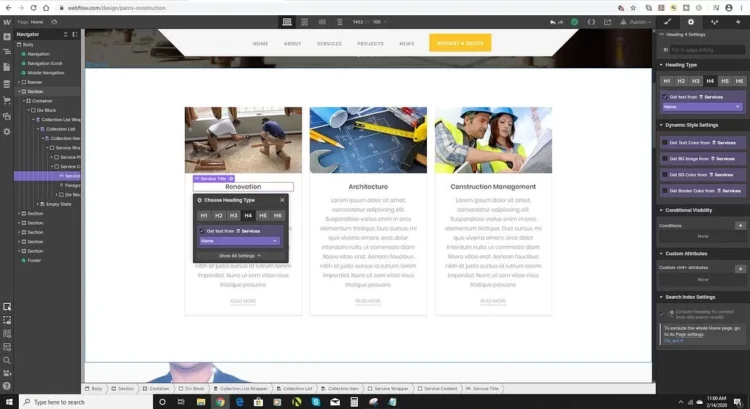
Source: Webflow forum
- Ease of Use:
The best part about Webflow is that it is great for small business owners that are looking for a quick but great looking website made in days instead of months.
Webflow developers can simply drag all the right blocks on the page, change their colors and font sizes and add content. And the website is ready for operations. There are simply no caveats involved.
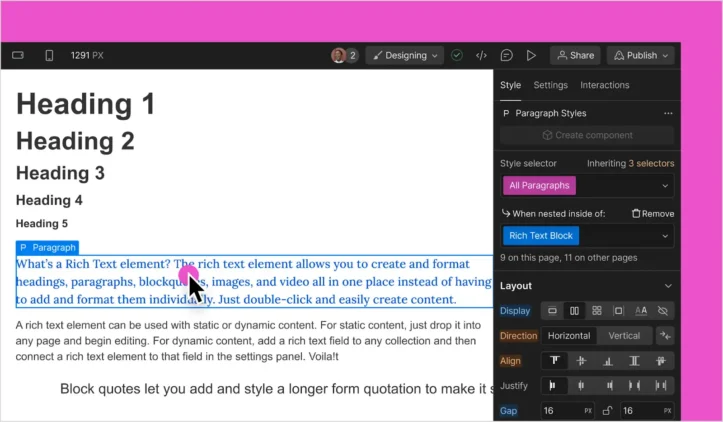
Source: Webflow University
- SEO Capabilities:
When it comes to SEO, Webflow is constantly updating its platform to add requested changes from the SEO community. Basic things like meta titles, descriptions, keywords, url canonicals, and even site hierarchy setup is fairly easy.
However, Webflow still doesn’t have a built-in option for schema. So you have to use the JSON schema code on your pages where you want the schema mark-up to be spotted by the crawlers.
Link building is also very easy since Webflow offers two user access options – developers and editors.
Anyone who is an editor can edit content on any page of the website without issues.
- CMS Management:
Webflow is created as a full-scale website management platform and it also has a working CMS. But unlike WordPress, the CMS platform is not pre-built with the website designer. You have to buy a separate Webflow package of $29 per month to get the CMS functionality enabled on your website.
Even then, the creation of CMS is a little steep. You need to create a CMS block for your blogs or any other resource section that you want dynamically populated. This will include adding all the properties that will be reflected in the blog section like headings, body area, authors, categories, and anything else. Think of this part as similar to the ACF module in WordPress but without code.
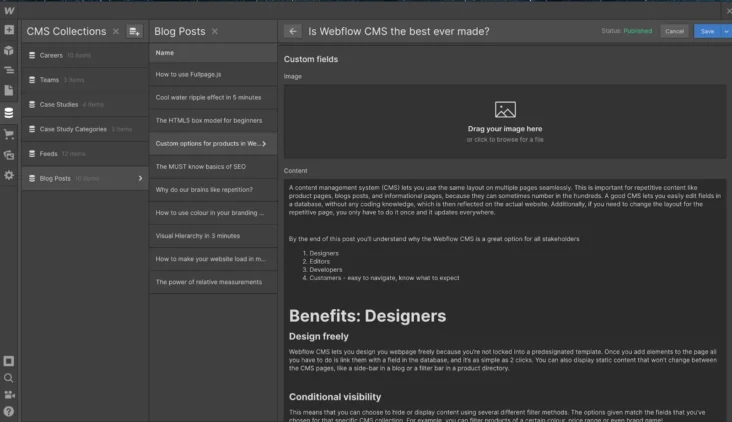
- Forms & Flows:
Webflow also offers its own lead forms and flows that allows any business to generate and collect leads while staying on the platform. It is great for small businesses that cannot afford a CMS platform and rely on their website for leads management.
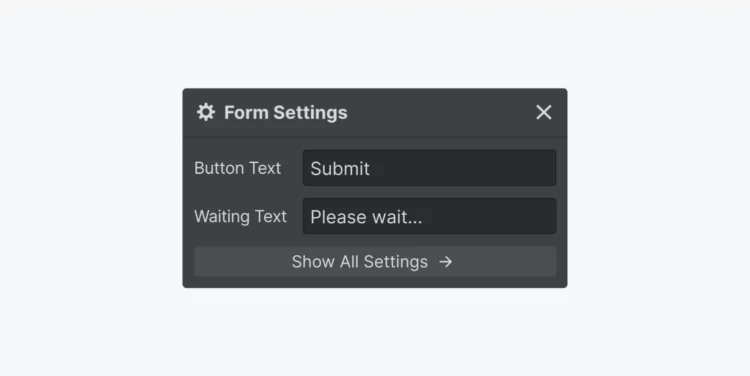
Source: Webflow University
Pricing for Webflow
Webflow offers a range of plans tailored to different needs, starting with the Starter plan, which is free 2 pages, 20 CMS collections, and 1 GB bandwidth. However, you cannot use your own domain with it.
The Basic plan starts with $14/month and is suitable for static sites, offering 150 pages, a custom domain, and 10 GB bandwidth.
The CMS plan is ideal for content-driven sites and costs $23/month and includes 20 CMS collections, 2,000 CMS items, and 50 GB bandwidth.
The Business plan, designed for larger sites, is $39/month billed yearly, offering 40 CMS collections, 10,000 CMS items, and 100 GB bandwidth.
Limitations of Webflow for Marketers
- Webflow doesn’t offer a lot of flexibility when it comes to SEO. You will have to either use JavaScript to get most technical aspects covered or use manual options available online like Redirections, Schema Markup, Canonicalization, Pagination, and even image optimisations
- Webflow is very difficult to operate for multilingual websites when it comes to designing and marketing
- Animations and interactions on the platform can become very heavy and sometimes slow down the websites
- You are dependent on the platform for everything and to be honest the support of webflow is not readily available. We personally have experienced delays of at least 2 days in the replies from the support team at Webflow. Sometimes this could have a major impact on your website and brand reputation.
- Finally, the most important one. You are limited by the package that you choose. If you are on a CMS package, you have a set number of pages and CMS items that you can create. This can impact your site scalability.
How WordPress Helps Marketers? Quick Overview
WordPress.org is one of the most comprehensive website development systems out there. Initially it started as a CMS but now it encompasses many other aspects of development and marketing and therefore it would not be wrong to call it an ecosystem. It is powering 63% websites available online which means every second website you visit online is built with WordPress. So there is no doubt that WordPress offers something for everyone.
- Design Functionality
For starters, WordPress offers a unique theme based platform that allows users to create their website without the need to hire a third-party developer. But this is just for starter websites. Most websites built on WordPress use it because of the customisation options available on this platform that are available nowhere else.
Globally, it is being used for all types of websites SaaS, ecommerce, enterprise, small business, and whatnot.
Users can create any type of website they want without any limitations or restrictions from the platform.
- Ease of Use
WordPress offers theme based development. Users can start with either a free theme or a paid theme, install and customise it in a way they like and publish their website online.
- Plugins
WordPress also offers thousands of plugins from reputed developers that users can add to their websites for adding new functionalities that they require for the business.
- Taxonomies
Another great benefit of using WordPress is the use of taxonomies. This allows WordPress users to add any type of asset to their website without any limitations. Taxonomies are basically categories or segments like Posts, Videos, Audios, etc. Based on business needs, they can be changed and added in a way the site owners require.
- Page Builders & Modules
Last but not the least, WordPress allows users to also add third-party page builders and modules like ACF Modules, Elementor, Beaver Builder, and more. These modules give more custom options to the site owners allowing them to easily add any type of functionality or fold on the website to make it more attractive to the end users.
Some examples for these include adding content in three columns instead of one, formatting CTAs with buttons and text so that it looks more clickable.
- SEO Functionality
WordPress offers some of the best plugins for managing on-page SEO on your website. These include All in One SEO, Yoast SEO, Rankmath SEO. All these plugins are known for making website SEO a piece of cake for beginners. These plugins offer built-in checklists that analyse the content of the website and offer ways to improve the scores for better rankings in search engines.
Apart from this, WordPress also offers schema markup and FAQs options with the help of plugins. That users can directly add to any page of their website with the help of shortcodes.
- Platform Pricing
WordPress.org is free as it is an open-source platform. However, there is a cost of the hosting solution that you use for your website. This could range from $10 per month to $50 per month depending on the type of hosting selected.
- Development Cost
Most WordPress website owners use development agencies to build their websites in a professional way. The cost of these development services can be around $10,000 to $50,000 depending on the type of designs created.
Designs that are rich in animations, interactions, and functionalities are bound to have higher costs.
Features & Limitations: Comparison Table for Webflow vs WordPress
| Feature | Webflow | WordPress |
| Design Flexibility | Module-based with customisable template blocks; each page can be uniquely designed. | Theme-based with vast customisation options; supports third-party page builders like Elementor. |
| Ease of Use | Drag-and-drop, no-code builder; suitable for quick website creation. | Theme installation with plugin support; some technical knowledge may be required. |
| SEO Capabilities | Basic SEO features, but lacks built-in schema support; easy content editing. | Advanced SEO plugins like Yoast and RankMath offer comprehensive SEO management. |
| CMS Management | Requires a separate CMS plan; CMS creation is manual and complex. | Built-in CMS functionality with taxonomies for flexible content management. |
| Forms & Flows | Integrated lead forms; suitable for small businesses. | Extensive plugin support for advanced form creation and management. |
| Pricing | Starts free; CMS plan at $23/month; Business plan at $39/month. | Free platform; hosting costs range from $10 to $50/month. Development costs vary based on customisation. |
| Scalability | Limited by the chosen package; CMS items and pages have set limits. | Highly scalable; no limitations on the number of pages or content types. |
| Platform Dependency | Fully dependent on Webflow’s platform; support can be slow. | Open-source with extensive community support; flexibility in hosting and management. |
| Best For | Marketers looking for a no-code, quick setup with basic SEO and lead generation needs. | Marketers needing advanced customisation, SEO capabilities, and extensive plugin support. |
| Development Costs | Starts at $5,000 USD with limitations in design flexibility. | Starts at $10,000 USD or more with fewer design limitations. |
How We Compared Webflow & WordPress?
Our agency has been creating websites for our clients on both platforms so we are very much familiar with the intricacies that each platform offers. But for the creation of this post.
- Our developers tested both the platforms for each feature we have mentioned.
- We used the CMS package for Webflow and the WordPress.org installation of the website on Kinsta.com
- Both platforms were tested for CMS functionalities, drag and drop features, custom codes, and SEO functionalities directly on the platforms by our own team of SEO experts.
- We also checked the eligibility of both the platforms on paid platforms like Google Ads, LinkedIn Ads to make sure how is the performance of both the platforms on each of these platforms before giving our final verdict.
Despite the potential for further exploration, our current experiments lead us to the following conclusion.
Final Verdict: Webflow vs WordPress – Which One Should You Use?
Who should use Webflow?
It is ideal for those who are working on small business websites and do not require a lot of customisation options. The platform offers basic design options that will fulfil the needs of most websites. It is also great for marketers that are working with businesses that want to market their business through paid channels rather than organic channels as the platform makes it very easy to create and market new pages with minimum effort.
Who should use WordPress?
It is ideal for marketers that are looking for omni-channel marketing. Marketers that require extensive customisations, advanced features, and a robust ecosystem of plugins and themes to get their work done can benefit from WordPress. It’s also highly flexible, supports comprehensive SEO management, and offers better multilingual support.
In the end, choosing between the two depends on your specific needs: Webflow for a streamlined, design-focused approach or WordPress for a more versatile, feature-rich platform.
At WP Creative, we specialise in crafting custom WordPress solutions tailored to your unique marketing needs. Whether you’re looking for advanced customisations, unique features, or seamless SEO integration, our expert team is here to help you unlock the full potential of WordPress. Contact us today to start building a website that not only meets but exceeds your expectations.
